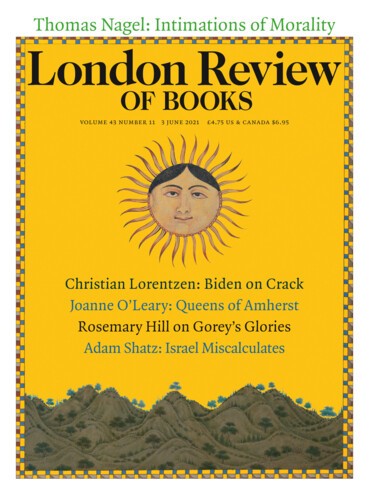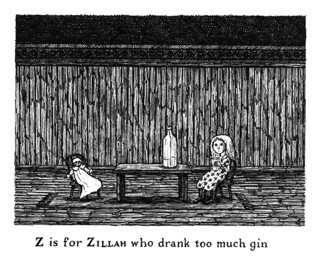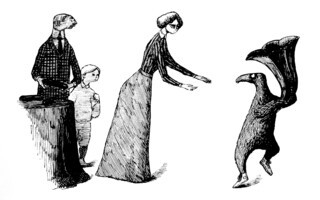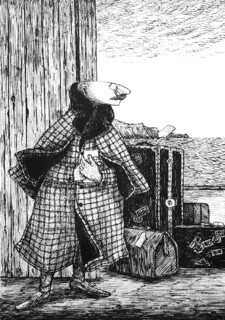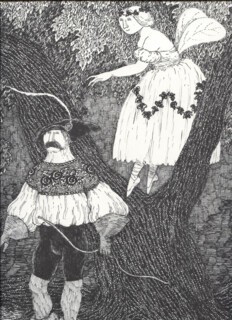‘What were you like as a child?’ Dick Cavett asked Edward Gorey on his talk show in November 1977. ‘Small,’ he replied. Gorey, who died in 2000 at the age of 75, did not like to talk about himself or his work, which depended, like the Japanese literature he admired, ‘very much [on] what is left out’. Someone who thought of himself principally as a writer, but is now remembered chiefly as an artist and illustrator of his own and other people’s work, Gorey created a peculiar, hermetic world in which the comic and the macabre combine in proportions dependent on the reader’s temperament. It has been described variously as Edwardian, Jazz Age, avant-retro, surreal, picturesque and English; Gorey said it had the effect of ‘Victorian novels all scrunched up’. The only really accurate word is ‘Goreyesque’. The term was in circulation by the time of his death, and doubtless long before among aficionados. When he did the Cavett interview Gorey was no longer a cult figure. His set and costume designs for a hit Broadway production of Dracula had brought him recognition and a great deal of money. Soon he had a Tony Award, which he gave away to a friend. By the 1980s he was famous. But he remains a specialised taste. His father, to whom he wasn’t close, described the way his son divided opinion: ‘He has you either amused – or clutching the chandelier.’
Cavett’s question about Gorey’s childhood was presumably prompted by the number of children who appear in his work and the regularity with which they come to terrible ends. One of his most popular books, The Gashlycrumb Tinies: or, After the Outing, first published in 1963, is an Abecedary in the Victorian style: 26 children meet their deaths in different ways, from ‘A is for Amy who fell down the stairs’ to ‘Z is for Zillah who drank too much gin.’ The outing of the title is never disclosed. The tinies are gathered on the front cover as if for a school photograph while behind them stands a supervisory skeleton in mourner’s weeds, one hand outstretched, the other holding an umbrella. On the back cover are 26 little headstones. Like many of Gorey’s figures, the tinies are mostly passive and meet their fates with stoicism. Many are drawn without mouths, so that protest, should they wish to make any, is impossible. Misguidedly, if not surprisingly, publishers consistently resisted Gorey’s attempts to market his books to children. The Beastly Baby (1962) brought on palpitations in Cap Pearce, his editor at Duell, Sloan and Pearce. ‘He even dragged out a bottle and gave me a drink,’ Gorey told his friend Alison Lurie, ‘this being eleven o’clock in the morning.’ Lurie, to whom he had sent a copy, reported that her own children were loving it. Pearce’s mistake, like Cavett’s in asking about Gorey’s own childhood, was to see the children in the work from the perspective of an adult, and to assume that Gorey did too. Yet, as his occasional collaborator Peter Neumeyer remarked: ‘Of all the people I’ve known nobody has been less interested in children.’ He had no memory of Gorey ever even using the word ‘child’.
What Gorey understood was not children, but the perspective of childhood and its lack of sentiment. Himself a childless only child, his response to Cavett’s question wasn’t perhaps entirely flippant. Size was a more noticeable factor than age in his relationship to his childhood self. Vulnerability, ignorance (which is not the same as innocence) and the necessity of accepting an apparently endless succession of baffling and sometimes alarming developments are the essential experiences of childhood which adults, especially when they become parents, tend to forget. Gorey not only didn’t forget, he never saw the world any differently. Life remained ‘intrinsically … boring and dangerous at the same time. At any given moment the floor may open up. Of course, it almost never does; that’s what makes it so boring.’
The child can also wreak reciprocal havoc on the bewildering world, as happens in one of Gorey’s earliest books, The Doubtful Guest (1957), a story told in monochrome illustrations and rhyming couplets. The guest, which is only visible in profile, is not a human child but a creature who continued to haunt Gorey’s work thereafter, a mournful looking being about three feet tall with no obvious mouth and an eye on each side of a drooping nose, or possibly beak. ‘Something between a penguin and a lizard’ was Gorey’s own, characteristically opaque description. The guest arrives without warning or explanation at the home of what appears to be an Edwardian family of five. It is wearing tennis shoes and a Harvard scarf and stays for seventeen years, making a nuisance of itself by tearing up books, dropping objects into the garden pond and, occasionally, simply standing with its nose against the wall and refusing to move.
Lurie believed, no doubt rightly, that the guest was inspired by her description of motherhood and ‘my inexplicable (to him) decision to reproduce’: ‘I said that having a young child around all the time was like having a houseguest who never said anything and never left.’ She pointed out the guest’s childlike characteristics:
[It is] smaller than anyone in the family … has a peculiar appearance … and does not understand language. As time passes it becomes greedy and destructive … has temper tantrums … yet nobody even tries to get rid of the creature; their attitude toward it remains one of resigned acceptance … after about seventeen years most children leave home.
Gorey’s guest, however, neither grows up nor leaves. The last page shows the family, whose human son has become an adult complete with moustache, standing in a conversational group. None of them is looking at the guest, who is still the same size and sits on a tasselled pouffe staring blankly in the opposite direction. ‘It came seventeen years ago – and to this day/It has shown no intention of going away.’ Gorey, similarly, stuck with his own unusually angled view. The Doubtful Guest appeared in the same year as The Cat in the Hat, which splashed primary colours across the bland landscape of 1950s children’s books, licensing naughtiness and doing away with what Mark Dery describes as ‘those insipid, boring goody-goodys Dick and Jane’. The Cat in the Hat was an instant hit and transformed children’s publishing in the US. The Doubtful Guest sank almost without trace; its few reviews, Gorey noted gloomily, all dwelt on ‘how peculiar it is’.
Dery is an enthusiastic if unevenly perceptive biographer. Wisely, he does not dwell on what he calls – in a parody of Gorey’s own parodic Victorian titles – ‘A Suspiciously Normal Childhood’. A single chapter takes Gorey from his birth in Chicago in 1925 to the summer of 1944, when he was a conscript sitting out the war as a company clerk at an army base in the Great Salt Lake Desert, ‘a ghastly place … we kept ourselves sloshed on tequila, which wasn’t rationed.’ His father was a newspaperman, a reporter then an editor; his mother was a housewife who adored her precocious son. Gorey was reading by the age of three and at eight had begun working his way through the complete Victor Hugo, for reasons he could not in later life reconstruct. His parents’ unhappy marriage, their divorce and (much later) remarriage, were no doubt unsettling, but there was no Gothic horror in his upbringing of the sort that his more literal-minded admirers expected to find. Demobbed in 1946, he took up his deferred place at Harvard where, with what he came to consider a ‘hysterical disregard for practicality’, he decided to major in French. For his English classes he wrote Firbankian short stories in a manner an unsympathetic tutor described as ‘rococo’, derived from ‘self-consciousness and reading’ and in some instances made ‘more than usually irritating by meagre content spread very thin’. The poet John Ciardi, who also taught him, was more perceptive, suggesting that when Gorey found his voice his writing would be ‘either transcendent or simply pointless, depending on whether you follow it into some idea of order, or merely into the bric-à-brac of amusing reverie’. What Gorey found eventually was a way of being transcendent while hanging on to the bric-à-brac, a peculiar poise which depended on not exposing his work to excessive daylight in the form of context or biography. Dery, however, is not to be put off. He sees his job as being ‘to get to the bottom of’ his subject. He is the biographer as inquisitor and in the opening chapter he shows us the instruments.
‘In the pages to come,’ he begins menacingly,
we’ll use the tools of psychobiography to make sense of Gorey’s relationships with his absent father and smothering mother and of the lifelong effects of growing up an only child with a prodigious intellect … Gay history, queer theory, and critical analyses of Wildean aesthetics and the sensibility of camp will be indispensable, too, in unravelling his tangled feelings about his sexuality and … the ‘queerness’ (or not) of his work. A familiarity with the ideas underpinning surrealism will help unpack his art … An understanding of Balanchine, Borges and Beckett will come in handy, as will an appreciation of Asian art and philosophy (especially Taoism), the visual eloquence of silent film, the mind-set of the Anglophile and the psychology of the obsessive collector.
Happily, it doesn’t come to that. Gorey is not clarified, unpacked, unravelled and left in pieces at the reader’s feet. As Dery admits in the next paragraph, his subject is ‘uncrackable’, so despite his baffling desire to crack him, the biographical toolkit turns out to contain nothing of much use. As an account of the facts of his life, however, the book makes for an engaging and informative read which were it half as long would be twice as enjoyable.
Gorey’s first book, The Unstrung Harp, was published in 1953, the year he moved to New York. He was working for Anchor Books, a new imprint of Doubleday, set up for the production of ‘quality literature … in mass-market paperback format’. Despite his own literary ambitions and the fact that he was trying and failing to write a novel, Gorey wasn’t employed on the editorial side but in the art department, where he worked variously as a cover artist and book designer. It was here that he hit on the form and order that Ciardi saw he needed. Having no training in typographic design, he found marking up layouts for the printer difficult. In an early example of what Dery calls his avant-retroism, Gorey decided that rather than look up all the fonts and calculate the point sizes it was ‘simply easier to hand-letter the whole thing’. The use of manual processes to imitate technical ones became an essential feature of his work. The delicate cross-hatching that gives his monochrome illustrations the velvety depth of 19th-century engravings was all done by hand with a crow quill dip pen. Having worked out his modus operandi, Gorey became ‘fast and competent’ at his job and used the rest of his time at the office to produce his own books. It was in the triangulation between drawing and writing that he found the way out of his inability to write a novel and a means of putting his mental bric-à-brac in order. Like Alice, who can only reach the house in Through the Looking-Glass by turning her back to it, Gorey reversed the usual advice to ‘write what you know’ and wrote the apparent opposite of his own situation. The Unstrung Harp: or, Mr Earbrass Writes a Novel is an illustrated story about a successful elderly novelist who produces a new book every other year. We follow the process whereby his latest, The Unstrung Harp, is conceived and written through the ups and downs of the author’s working life, procrastination, inspiration and publication. This Gorey did know about, having observed the behaviour of writers and publishers at Doubleday. He considered it ‘scatter-brained to the point of lunacy’. Mr Earbrass attends a gloomy gathering of fellow authors at Le Trottoir Imbecile where the conversation consists of snide comments and complaints about the travails of literary life. His editors at Scuffle and Dustcough create endless difficulties, from an unsuitable cover design to a stingy allocation of free copies. After publication comes anti-climax. Mr Earbrass decides he will spend several weeks abroad, although, like the doubtful guest, we don’t actually see him leave. He remains on the last page standing beside his luggage ‘numb with cold and trepidation’.
Here, fully formed, was Gorey’s world. He was in his late twenties, but it wasn’t surprising that the readers who discovered him in slowly increasing numbers on both sides of the Atlantic thought that he was old, or even dead, and that in America they imagined he was English. He never visited England: it was unnecessary and might have been disastrous. The country where Mr Earbrass has his stately home, Hobbies Odd, near Collapsed Pudding in Mortshire, with its urns and gables, sofas, tea tables and snow-covered croquet lawn, is Gorey’s own invention, an emanation from Victorian and Edwardian novels. The spelling is mostly English but the vocabulary isn’t. Mr Earbrass has jelly in his sandwiches instead of jam and his tea comes from a coffee pot. Gorey’s imagery, as Dery notes, is in debt to the Surrealists, and, at times, in its use of line, to Aubrey Beardsley, but insofar as Gorey belongs to a genre it is the Romantic picturesque with its mood of inbetweenity; his favoured time is twilight and the recurrent mood is a shadowy, autumnal melancholy.
If Gorey was not ‘half in love’ with death like Keats, he was strongly attracted to it and, as he remarked when his own health was failing in later life, ‘not entirely enamoured of living forever’. His densely hatched scenery observes the conventions of landscape painting, with foreground, middle ground and background all so compressed as to create a mood of high atmospheric pressure. His sense of proportion was exact. What is strangely large, or unexpectedly small, immediately strikes the eye. In dealing with his own publishers he was more robust than Mr Earbrass. His ‘meticulous’ art boards, the production editor David Hough recalled, did not need editing and suggestions were not welcome. There was he said, ‘a bit of a ruckus’ over the hyphen in The Haunted Tea-Cosy.
By 1963, successive changes of job and imprint had left Gorey stranded as an unhappy employee of Bobbs-Merrill, a more corporate outfit than Doubleday, until a fortunate bout of managerial infighting led to his being fired. From then on he was freelance and later divided his time between New York and Cape Cod. He had developed a way of life and a style of dress that in its combination of flamboyance and rigid routine was calculated to ward off the worst of the boredom while avoiding sudden and dangerous turns of events. His personal style was a version of Earbrass’s and had been in development since Harvard, where he wore long coats with fur or sheepskin collars. Unlike Earbrass, who is exactly the same height as all the other authors of his acquaintance and indeed of Glassglue, one of his minor characters, Gorey was tall, and already as a student ‘spooky looking’. He grew a long beard. In his work life, as in the work itself, all was strictly ordered. He always ate out in what a friend remembered as ‘one horrible restaurant or another’ and worked the same hours every day. His apartment at 36 East 38th Street was small and crammed to the ceilings with books, magazines, pieces of art and artefacts including various memento mori and a large figure of the crucified Christ. There was a low bed with no headboard, an unused kitchenette and an uncertain number of cats.
Some of this was self-conscious bohemianism, a reaction to the Norman Rockwell world of wholesome postwar American family life. Gorey’s style wasn’t entirely sui generis, although he was ahead of the curve. As the 1960s wear on in Dery’s account it becomes easier to see his growing popularity as an aspect of the revivalism of that decade, along with the craze for Art Nouveau posters, flowing floral frocks and the Beatles’ vintage military uniforms. Not that this made him more inclined to join in. One of the few visitors to his flat observed that ‘there was no room for two in that apartment – or in that life.’ Gorey had many friends, most of whom assumed that they were in some outer circle of acquaintance and that there must be an inner circle of intimates elsewhere. There wasn’t. Gorey neither wanted nor needed close relationships and he kept his friends in separate compartments. He had a particular horror of family life and its conventions, movingly expressed in ‘A Chthonian Christmas’, commissioned by Esquire for December 1966. A series of unseasonal scenes includes three children discovering Father strangled with a Christmas stocking. Gorey was, however, fond of his cousins, Elizabeth and Eleanor Garvey, and cousinship was perhaps the degree of separation he found most palatable. Cousins often feature in his stories and tend to come off better than parents or siblings. The Garveys’ children remember him treating them exactly as he treated adults. On the matter of his sexuality, to the cracking of which Dery applies much of his biographical batterie de cuisine, things seem perfectly clear. Pressed by an interviewer for Boston Magazine in 1980, who asked ‘What are your sexual preferences?’, Gorey replied: ‘Well, I’m neither one thing nor the other particularly. I suppose I’m gay. But I don’t really identify with it much.’ For Dery this polite response to an intrusive question is a ‘dodge’ but the evidence of the rest of Gorey’s life, in which there were several more or less unrequited crushes on men, but no long-term or close relationships, suggests he was telling the truth.
Gorey, like his books, was what he appeared to be. His dislike of intimacy was of a piece with his distaste for over-explanation. An admirer of Jane Austen, he hated Henry James for his characters’ ‘unpleasant arid curiosity’. He might have felt the same about Dery, who is similarly prone to ‘inexhaustible questionings, probings, pryings, comparings’. ‘If anyone ever literally died of curiosity,’ Gorey wrote in a student essay, ‘I am certain it must have been a Jamesian character.’ When asked what he might choose for his epitaph, one of his suggestions was ‘not really’. The art form outside Gorey’s own work which most closely fitted its ethos was ballet, for which he had a passion. He loved in particular the work of the New York City Ballet under George Balanchine who in 1974 he considered ‘the great genius in the arts today’. Balanchine was as laconic as Gorey, who liked quoting the choreographer’s frequent advice in rehearsal, ‘Better don’t do.’
Ballet, untranslatable and ephemeral, is the opposite of James. Motive and character development are irrelevant, no two performances are identical. Gorey went to every performance. His balletomania partook of the same rigid routine as the rest of his life and after the Lincoln Centre’s theatre opened in 1964 it became ‘for all practical purposes’ his home for five months of the year. During the interval he would take up his position in the Grand Promenade ‘leaning in his full-length fur coat, in his full-length beard’ against one of Elie Nadelman’s massive statues of voluptuous female nudes, apparently just as much of a fixture. ‘You can often hear me bitching about somebody’s performance,’ he confessed, ‘but I’m bitching on a terribly high level.’ ‘Ballet in a Nutshell’, an illustration for Dance Magazine from 1974, shows a silhouetted figure comparing notes on the performance during the intermission. She remarks: ‘her feet are like baked potatoes wrapped in foil.’
In 1983 Balanchine died and Gorey, who always had mixed feelings about New York, went to live full time at Cape Cod. The house there, like his apartment, was filled with books, cats, pictures and objects. He resisted the term ‘collector’, preferring instead to call himself an ‘accumulator’, aware no doubt that this is ‘a device which accepts energy, stores energy, and releases energy as needed’. It is in his accumulation, rather than his biography, that the inquisitive reader can find an insight into Gorey’s mind, the backroom of his imagination. It is well described in Gorey’s Worlds, the catalogue which accompanied a 2018 exhibition at the Wadsworth Atheneum in Hartford, Connecticut (which now owns many of his possessions). Objects were carefully arranged, some by type, such as doorknobs, salt and pepper shakers, telephone-pole insulators and so on, others by shape. All the spherical objects were kept in the so-called Ball Room. As he became richer he bought more expensive art, much of it French: the mournful Paris of Charles Meryon, set designs by Rouault, a sheet of eyeballs by Redon and some of Atget’s gelatin silver prints, their ever receding fields of monochrome immanent, like Gorey’s landscapes, with some half-realised event. The relationship these things had to his own work was one of sympathy rather than influence. There are no images of children and the only living English artist to feature significantly is Glen Baxter, with whom Gorey became friendly and whose colourful scenes are apparently illustrations torn from unlikely stories unfolding elsewhere – these share some of Gorey’s humour while inhabiting more closely the world of cartoons and jokes.
As Gorey’s reputation grew, he enjoyed the money but disliked the fame. Some fans who wrote to him got a postcard saying ‘You’ve written to me to no avail/Because I never read my mail’; others didn’t. When he read that Carol Burnett answered all her fan letters he was aghast. ‘This isn’t possible! Are you insane? Have you no priorities?!’ Gorey’s priorities in his later years shifted from art to theatre with a series of playlets or ‘musical entertainments’ involving human actors and a variety of puppets and props of which the first, Lost Shoelaces (1987), set the pattern. Something between kabuki and Victorian parlour entertainment, the typical production, the Cape Cod Times advised readers, consisted of ‘a lot of unhinged characters wandering about in gardens, peering perplexedly in and out of windows, haunted by vague memories’. Some were hits and some were catastrophic flops; Gorey apparently neither minded nor noticed. At one performance in a largish theatre in Provincetown a friend remembered there were only three people in the audience, including Gorey himself, ‘who laughed away and enjoyed himself’ regardless. When not writing plays or sewing bean bag creatures for sale to raise funds for performances, Gorey’s last years at Cape Cod were spent contentedly watching reruns of Golden Girls surrounded by his cats and his accumulation. He put aside his New York look, dispensing with the fur coats and the rings, and established a new routine. He ate breakfast and lunch every day at Jack’s Outback, a café near his house where the owner’s memories of him strongly recall the Doubtful Guest. At first Gorey read a book while eating and refused to speak to other customers. The regulars however were determined to draw him out and after a difficult start they found him impossible to stop. Soon he was ringing up his own bill, often for implausible sums of thousands of dollars, intruding into private conversations, ‘and he was very opinionated’ until ‘at the end he was a tyrant.’
Send Letters To:
The Editor
London Review of Books,
28 Little Russell Street
London, WC1A 2HN
letters@lrb.co.uk
Please include name, address, and a telephone number.
